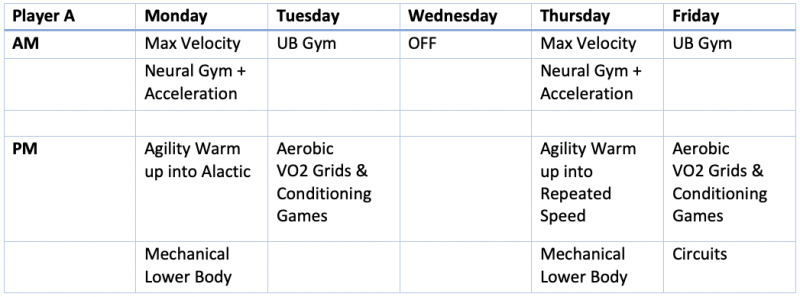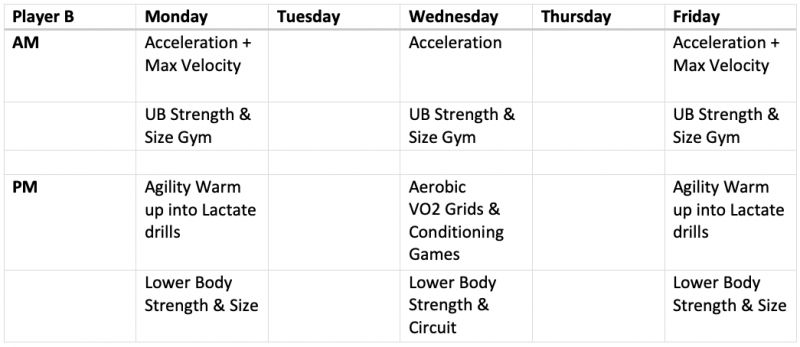
As many of you would know, I believe in the conjugate or concurrent style of programming as one of the best methodologies to improve performance in all sports. Also, I have simplicity as my core belief, and with these ideas in mind, I would like to detail a model for team sports programming, especially for off and pre-season development.
The three key improvement areas in programming for team sports are Fitter, Faster, and Stronger. While these are certainly, stand-alone concepts, I think you can break them down further into their parts.
- Fitter: Anaerobic Alactate, Anaerobic Lactate, and Aerobic
- Faster: Agility/Change of Direction, Acceleration, and Maximal Velocity
- Stronger: Neural (Power & Strength), Mechanical (Strength & Size), Metabolic (Strength Endurance & Aerobic)
The next step is working with both the position coach and the player to determine what the specific work-ons are for the next period. If there are specific skill work-ons that are identified, what component of the skill could be improved by addressing physical aspects as well as concurrently? For example, in basketball, a player does not “post up” strongly in the paint, or he finds it difficult to “box out” effectively. Both of these skills may well benefit from an increase in size and strength, which is definitely in our domain. Also, it could be foot work. So, there are huge performance advantages from developing this synergy with the coaching staff, which I believe increases “buy-in” from the player as well.
RECENT: Relationships and Team Dynamics
After you have ascertained key areas to improve, you now need to consider the percentage of time you devote to the sub-categories that I have listed above. Now the key to this is to remember that everyone on the planet will have a different percentage allocation to you, and that is perfectly okay. Remember that it is your program, and you are the one developing it with the athlete in question. Robust debate is good, but the buck stops with you.
This is especially important if you work in collegiate sports that are under the 20/8 NCAA rule, since you may only have four hours to try and cover all you need to in the physical development program.
The programming of the Faster element may look like this for two different players:

You will have exactly one hour to work with these two athletes. Do you just work on the area that you have decided has the highest percentage work on time, or do you work on each of the three areas? I would favor method two and allocate specific times for each component based on my review with the player and position coach. You may need a coach to run a component for you, which is what I often do, ensuring that I am rotating through the three areas regularly but also giving my time to the most difficult area.
The same can be done with the other two categories of physical development, firstly Strength:

And finally, Fitness:

Since I work in a professional environment, I have extra time at my disposal. Still, of course, I need to be aware of the demands on the player and their ability to recover between sessions to achieve my goals for them.
Based on the allocation of training time to these two players across the three key training categories, my plan can now take shape in the course of the training week. There will be rugby team sessions as well as unit skills sessions and individual skill sessions to complete. Still, for the sake of this programming example, I will exclude them from the planning unless I can integrate them into the session as an advantageous use of time and resources.
Be aware of positional requirements as well, as these may influence the amount of time allocated from the initial assessment. To analyze each player, it would appear that Player A appears to be a heavy neural dominance in the programming, whilst Player B appears to be more acceleration with strength and size.
As I have often said, the strength and conditioning aspects of the program are like the tutorials of a university education program; the lectures (rugby content) are compulsory, and then we fit the tutorials around the week plan to ensure specific needs are met. This means more work for the strength and conditioning staff but ensures that each player’s needs are met, and the overall performance of the team is improved. Team first is a basic tenet of all successful programs.
It is very important to discuss this style of programming with the team to ensure they understand what you are attempting to do since it would appear from first glance that some players are getting more time off than others. The reality is that the program content hours are almost identical; it is just how those hours are distributed across the week that is different. In the examples listed below, Player A has 13 sessions a week devoted to strength and conditioning elements, whereas Player B has 12 sessions. To these, the specific rugby sessions will need to be included to complete the program.


My sincere thanks to Chris McCormick, Director of Strength and Conditioning for Olympic Sports.
As I have mentioned previously, I believe that the individualization of programming in team sports is the real holy grail of strength and conditioning. To this end, the application of the 3x3 programming matrix will ensure that each player will have the best opportunity to improve in the areas that they need most, and the team as a complete unit is in the best possible place to start the training year. As Brett Bartholomew would say, “A rising tide raises all ships.”
Florida Atlantic University, as this article developed from a recent Zoom call and stimulated me to clarify my thoughts.











2 Comments